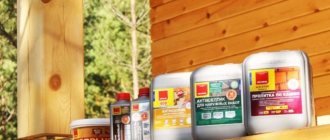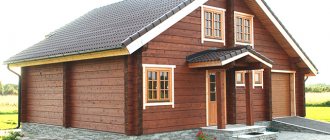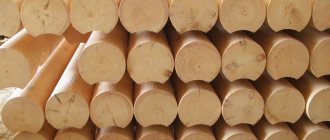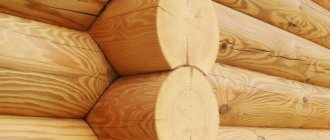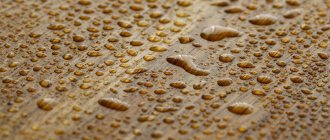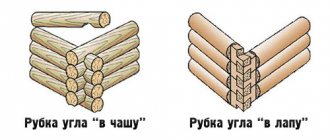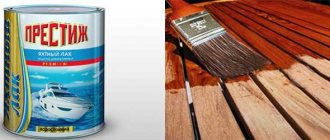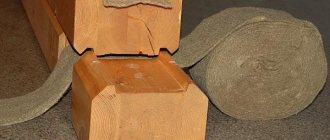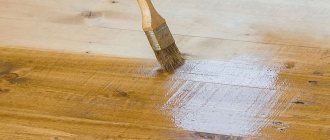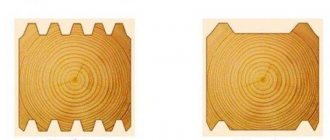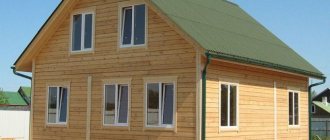Treating a log house with an antiseptic is one of the mandatory steps in the construction of a wooden house, a bathhouse or any other structure made from a log house. Wood is susceptible to negative natural factors, so it needs mandatory protection. This is especially important for a log bathhouse, since due to constantly high humidity and sudden temperature changes, the wood is much more at risk of rotting. Which antiseptic is best to choose for a log house, and how to properly carry out protective treatment?
Why do you need to treat the sheathing with an antiseptic?
Treating the sheathing with an antiseptic is a procedure that ensures the safety and durability of the most inaccessible element of the rafter system. Wood is one of the materials most susceptible to biological damage - mold and mildew, rot, and attacks by insects and rodents. If protective measures are not taken, the appearance of one or another factor is a matter of time. The affected sheathing loses mechanical strength and sags, forming defects in the roofing covering. The service life of all elements is significantly reduced.
- Choosing an antiseptic for rafters
A ventilation gap is created between the roof and the vapor barrier, allowing the removal of moist air and helping to dry the lower surface of the roofing sheet. Condensation forms on it, which also falls on the wooden sheathing. If the material is not treated, exposure to moisture will certainly cause irreversible consequences. The problem is that they become noticeable only at a later stage, when the most complex restoration work is required - dismantling the roof, removing rotten sheathing and installing a new subsystem. If this is not treated, after some time this procedure will have to be repeated.
In addition, it is necessary to take into account the location of the sheathing. It is located between the vapor barrier and the roof. Access to the material after laying the roof covering is terminated, regardless of the type of roof. It can be insulated or uninsulated (unheated); to gain access, you must either remove the vapor barrier film from the attic side or dismantle the roof.
Therefore, treating the sheathing boards before installation is the only protective procedure that can be performed to preserve the wood.
Does the counter-lattice need to be treated?
The counter-grill is an element that ensures the very presence and size of the ventilation gap between the roof and the vapor barrier. From a design point of view, this is a support system for the sheathing that performs load-bearing functions. The material for manufacturing is also coniferous wood, and the repairability of counter battens is even lower than that of sheathing.
The counter battens are in direct contact with the sheathing boards. If they are not processed, there is a risk of infection not only for them, but also for all adjacent elements.
Therefore, the processing procedure must be carried out for all structural elements. Moreover, the treatment is carried out before installation, and applying protective compounds to only one subsystem looks somewhat strange.
It must be taken into account that there is also an opposite point of view. Some sources claim that only high-quality drying matters for wood. There is an opinion that some antiseptics (salt impregnations) only promote condensation and cause increased wetting of the wood. However, all these statements have little correlation with current practice. In addition, ordinary common sense requires the use of all available protective measures.
Causes and process of material decay
There are several main factors for the occurrence of rotting and destruction of the operational properties of wood products, these include:
- exposure to precipitation: rain and snow;
- contact with melting snow and the influence of water resulting from this;
- wind mixed with dust;
- the origin and vital activity of insects and various microorganisms.
The process of destruction of wood untreated with a special composition begins to occur unnoticed. After some time, rot appears, which not only spoils the appearance of the structure, but also reduces its durability. Excess moisture is the main reason contributing to the destruction process, since it promotes the formation of fungus on the surface, after which a favorable environment for the reproduction of wood beetles is formed, undermining wood cellulose fibers.
Wooden timber should be treated with specially designed antiseptics to protect it from pests and rot.
It is important to note that structures on which rot and mold have formed have a negative impact on the human body. Spores of rot and fungus that appear in cold corners enter the lungs and contribute to the development of chronic diseases. Things stored near rotting wood absorb its smell and quickly become unusable.
The easiest way to avoid unpleasant surprises is to strictly follow the rules for carrying out waterproofing measures and select high-quality materials for construction, as well as proper protection.
Review of antiseptics for lathing
To process the sheathing, the same compounds are used as for other wooden structures. The most effective and durable compounds are selected that can provide protection against all possible threats. There are a large number of antiseptics on sale that have different properties and are designed to protect against certain types of biological damage. There are special formulations designed to prevent fungal infections, mold and other microbiological infections. There are antiseptics designed to protect against insects, in particular against the appearance of the borer beetle.
Experts recommend preferring universal compositions that can perform a complex effect on the material. It is impossible to foresee in advance what types of damage threaten the material during operation.
It must be taken into account that the vast majority of warehouses are infected with fungus and other types of microflora. The efforts of the owners to clean out the storage do not provide a complete guarantee, therefore, it is better to be prepared for any threats.
In addition, it is necessary to take into account the climate and the specifics of the region in relation to possible biological damage. Northern regions are less susceptible to insect attacks, but they are characterized by high humidity and temperature changes. In the southern regions, the danger of defeat increases sharply, and the need for protection becomes obvious.
Requirements for protective composition
Antiseptic formulations must meet the following requirements:
- safety for people and animals
- efficiency, the ability to protect wood from the maximum number of biological threats
- the ability to penetrate wood to a great depth, which determines the degree of protection and makes the compositions the most effective
- the ability to release water vapor from solid wood so that the material can dry naturally
- durability, the ability to provide protection for the longest possible period
- simplicity and ease of storage, as well as bringing the composition into working condition
- ease of application
In order to choose the best composition, you need to carefully study the information on the packaging. It details all the properties and technical characteristics of this composition. All that remains is to compare its indicators with the conditions and features of operation of the sheathing.
Types and characteristics
Existing materials can be divided into groups that have certain characteristics. Depending on the intensity of the impact, they are distinguished:
- preventive antiseptics. They provide minimal protection against possible biological damage and are used for structures operating in fairly favorable conditions
- medicinal antiseptics. They are applied to problematic wood with obvious fungal infections, and are also used for structures operating in difficult conditions.
In addition, the compositions are distinguished by specificity:
- targeted antiseptics. They are designed to address specific threats and do not have a universal impact
- universal compositions with the possibility of complex effects
As a rule, targeted compositions are used in regions where there are outbreaks of certain insects, microorganisms and microflora. Universal formulations have a predominantly preventive effect.
The composition of antiseptics is:
- water-soluble, used for preventive purposes, not able to penetrate deeply into solid wood
- oil Provide high-quality protection from getting wet, which eliminates the development of mold or mildew. They penetrate deeply into the massif, but have an increased fire hazard and emit a pungent odor
- compositions based on organic solvents. They are able to impart hydrophobic qualities to wood, improve adhesion, and create a protective film on the surface. Do not apply if the material is subjected to mechanical stress, as a result of which the coating can be removed
- combined formulations. They have the ability to perform several functions at once (as a rule, they are designed to combine antiseptic and fire retardant treatment)
- winter antiseptics. They can be applied at temperatures down to -15 °C, which significantly extends the construction time of the roof
According to the ability to adhere to the material:
- washable antiseptics. As a rule, these are aqueous solutions of salts
- non-washable compounds. These are liquids that have the ability to penetrate deeply into solid wood and maintain their performance throughout the entire service life of the structure.
The choice of one composition or another is determined by the operational and climatic characteristics of the lathing. As a rule, certain compositions are preferred in each region. They have maximum efficiency under existing conditions, which contributes to increased interest among specialists and ordinary users.
Application methods
Application of an antiseptic is a procedure that is carried out based on the type and characteristics of the selected composition. All available options are used:
- application using brushes and rollers
- spray, air or airless
- immersing the sheathing boards in baths with an antiseptic composition
When choosing a suitable method, it is based on the size of the roof and the volume of wood to be processed. Manual application of antiseptic is suitable only for relatively small roofs with a sparse type of sheathing. Large volumes of material cannot be processed manually - it will require too much time and effort, and the boards themselves must be placed somewhere. In such cases, spraying or direct immersion into the composition is used.
Special baths are made for immersion impregnation. They are frames made of boards, inside of which solid strips of polyethylene sleeves are laid. The length of the tubs should be slightly larger than the size of the sheathing so that the board can be completely submerged.
The processing is carried out by two people. Take the bar and lower it into the bath. Let it sit for a couple of minutes, then take it out and place it on the edge, allowing the excess antiseptic to drain back into the container. Then the board is laid to dry, and the next one is placed in the bath. To speed up the procedure, several baths are made so that you do not have to wait until the composition wets the board well enough.
As a rule, the antiseptic is applied in two layers. Between them, the material must be completely dried, otherwise the second layer may simply wash away the previous one. The duration of exposure is indicated on the packaging of the composition. Before application, you must carefully study the information - there may be special requirements for conditions or application methods.
Validity
The duration of action of antiseptic compounds is their weakest point and the strongest argument of opponents of this procedure. Depending on the type and basis of a particular composition, the service life can be:
- 5-7 years for aqueous saline solutions
- 10-15 years for oil impregnations
- up to 50 years for aggressive oil-polymer compositions
A striking example of durable impregnation is creosote. It is able to maintain working qualities throughout the entire service life of the wooden structure. However, this composition is not used for processing sheathing and other structures of the rafter system - during the entire period of operation it emits a pungent odor, due to which all users refuse to use the composition.
The use of short-lived antiseptics is recommended for dry and healthy wood, which is used under normal conditions. If certain problems with moisture and microbiological damage are possible, oil impregnations are chosen.
How to choose an effective impregnation?
The variety of antiseptic agents for wooden products is quite large. Impregnations are divided into types according to the characteristics of their use:
- Internal - external. Impregnations for external treatment are more effective, but their level of toxicity is higher than that of internal agents, which have a gentle effect on harmful microorganisms without affecting the human body;
- Organic - inorganic. Impregnations of organic origin are effective, but harmful. The inorganic product does not remain on the treated surface for long, due to which the harmful effects on humans are reduced to zero.
- Aquatic - non-aquatic. Water impregnation is a concentrate of salts of organic and inorganic nature, which have a surface effect or penetrate deep into the material. Non-aqueous impregnations may include a mixture of auxiliary components or just one active element.
Impregnations for wood against moisture and rot are often used in combination with fire-resistant agents, which give the wood additional protection and extend its service life. You can often find drying oils and paints that have a disinfecting effect, in addition to decorative functions; thanks to this property, the protection of wooden products is ensured. Separately, we can highlight oil compositions that have a comprehensive effect on wood and preserve cellulose fibers and destroy microorganisms.
Thus, in specialized stores you can purchase different options for impregnation, both in the form of a solution and in the form of a paste. They should be applied not only to the wooden surface, but also to the joints with the ground.
For treating wood that is constantly in the ground, only specific types of antiseptics and impregnations are suitable. Make sure that the product has moisture-resistant properties, since being in the ground contributes to increased exposure to salts, precipitation and water.
The most popular antiseptics - what is the best treatment?
The number of antiseptics available in the assortment of retail chains is very large. The appropriate composition should be selected based on its working qualities, type and specificity of action. In order to avoid mistakes, you need to have an idea about the best and most popular antiseptics. Let's consider several formulations that are in maximum demand:
Senezh Ognebio
This is a hard-to-wash, universal composition, presented in a ready-to-use form. It is a solution of salts in water, designed to protect wood under conditions of condensation and hygroscopic moisture. The manufacturer determines the service life of bioprotection at 30-35 years.
Pinotex Impra
Composition developed by Estonian manufacturers. It is highly effective, despite the fact that the specialization of this antiseptic is the rafter system and sheathing. The composition contains an aqueous solution of salts, emulsified with alkyd resin as a binder component. Capable of penetrating deeply into solid wood and providing protection against all types of microbiological damage and insects.
Drevotex
Composition from a Russian manufacturer. Provides effective protection against fungus, mold, rot. The antiseptic is classified as difficult to wash out, and the declared service life is 30 years.
There are other formulations on sale, but it is pointless to describe them all. It is necessary to consider their performance qualities only taking into account the specifics and conditions of use. Information from manufacturers sometimes seems somewhat exaggerated, especially regarding service life. However, even with certain adjustments for marketing, the properties of the proposed antiseptics make it possible to protect the sheathing from biological damage and insect attacks.
Folk remedies
There are many folk protective products for wood that allow you to treat the sheathing and preserve its condition for many years. Some of the most proven and effective formulations include:
Salt solution
A strong solution of salt in water. Apply in 2 layers with intermediate drying.
Machine oil (working off)
Applying machine oil (working off). It penetrates deep enough into the array, which ensures high moisture resistance and the ability to withstand biological attacks. However, such impregnation emits a specific odor.
Tar
Impregnation of the sheathing with birch tar. The disadvantage is a strong odor, but the effectiveness of this treatment is quite high.
Copper sulfate
Copper sulfate. Treating wood with a solution (10 g per bucket of warm water) allows you to neutralize all possible threats. However, the composition is aggressive towards metal fasteners.
Lime
Mortar. It is necessary to use quicklime, which is slaked and mixed with salt (1:10). You can add a little clay to create a surface protective layer.
Insects - no chance!
Tiny beetles can turn wooden furniture, walls and floors of your home into dust. Borer beetles, longhorned beetles and weevils, together with their larvae, slowly but surely destroy untreated building material. Only protecting wood from harmful insects will save the situation.
It is much easier and cheaper to take preventive measures than to replace damaged logs and beams. Insecticidal solutions will drive established pests out of their shelters and block the way for newcomers. You can use folk remedies - a solution of tar in turpentine, chlorophos, paraffin or a mixture of kerosene and carbolic acid. But formulations for professional processing are more effective.
Aqua-varnish Bor saturates the surface of the wood, protecting it from any negative manifestations from the outside, including beetles. It is used to cover window and door blocks, baseboards, stairs, railings, fences, and wooden walls of houses. Transparent impregnation does not distort the texture of the wood, it only changes its color to the desired one. The varnish can be diluted with water, but its percentage should not exceed 10%.
Protecting wood from bark beetles
Wood treatment to protect against bark beetle should be considered a separate procedure. It is produced when traces of the vital activity of these insects are found on the boards.
Drying oil
For treatment, hot drying oil is used, which is deeply absorbed into solid wood and penetrates into the passages of insects. The treatment is carried out by immersion in hot drying oil; applying it with a brush or spraying is impractical.
Kerosene and turpentine
There is another way to protect yourself from the bark beetle. Take kerosene and combine it with two parts of turpentine. The resulting mixture is injected into the passages with a syringe. The procedure is lengthy and not very effective. It’s easier to reject the material and buy other, healthy boards for the sheathing.
There are other folk remedies, but they are not suitable for applying to sheathing boards, as they are intended for processing small products.
Oil and propolis
An example of such an antiseptic is a mixture of vegetable oil and propolis (3:1). The components are expensive and quite specific; for application over large areas, the costs will be too high. There is no point in considering such compositions.
Surface coating with varnish
To do this, as in previous methods, the surface must be prepared: sand the wood and coat it with a primer. If the material is fresh, it should first be treated with stain. After the surface has dried from primer and putty, you can begin varnishing. The composition is applied using a bristle brush, roller or swab made of gauze and cotton wool. It is worth making sure that there are no streaks or smudges; the layers should be very thin. Each time you touch the surface, the brush should first be cleaned of excess varnish. The next layer can be applied only after the previous one has completely dried. Usually two or three passes are needed.
Universal antiseptics
Universal antiseptics have a complex effect and are able to protect wood not only from biological threats, but also from fire. There are a lot of such compounds on sale because they are in high demand. Users are attracted by the opportunity to apply all the necessary components and substances in one go.
It is necessary to choose universal formulations taking into account their effectiveness. It gives average indicators, which are in many ways inferior to individual compositions with a targeted type of impact. In any case, the mixture will not have the same effect as one specific chemical.
Therefore, universal antiseptics should be chosen only as a preventive measure for treating dry and healthy wood used under normal conditions.
If there are increased threats in the region due to microbiological damage or the presence of insects, specialized ones must be used along with universal formulations. At the same time, it is necessary to take into account that the composition applied last will work better. Therefore, it is recommended to first use a universal antiseptic, and apply a targeted composition with a specific action as a second layer.
